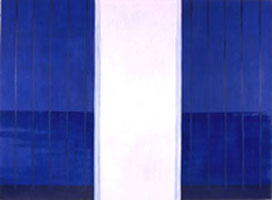
9-10/1999
ART
PAPERS MAGAZINE
Charlottesville,
VA., Jennifer Ditacchio
by Paul
Ryan
Employing abstract elements of the landscape and images
of architectural fragments, the new paintings of Jennifer Ditacchio (Second
Street Gallery, June 4-July 18) seek a poetics of transition. Passages
such as windows and spaces between buildings reveal views of open fields
or vast sea and sky, and this dual imagery serves as metaphor for a psychological
state of desire and spiritual possibility-in particular, an aspect of
consciousness that wavers between two thoughts or courses of action at
a philosophical level. Ditacchio’s intentions are ambitious and sincere,
and, although the results of the six large-scale paintings in the exhibition
are uneven, the viewer is left with a clear sense that this young painter
has the potential to become a strong presence in contemporary painting.
The strength of Ditacchio’s paintings is her brushwork- a "technical"
aspect of painting ultimately linked more to the intellect and emotions
than to the hand, and one that has been overshadowed in the last 20 years
by various conceptual strategies such as postmodern quotation and the
inclusion of text. Inherent within her brushwork alone-it’s simultaneous
speed and control, and Ditacchio’s innate understanding of paint
thickness/thinness and the painted edge-is both an amplitude of formal
issues and multiple veins of content. This is most evident in two paintings,
Field and Across,where
the representational imagery connected to Ditacchio’s conceptual
intentions is less specific, thereby allowing greater formal emphasis,
manipulation, and play. In Across, an elegant triptych of three adjacent
wooden panels, each 80 inches in height and 36 inches wide, the artist’s
central theme of obstruction or restriction vs. transition and (forward)
movement is resident; yet, it coincides with and mutually supports the
establishment of formal issues such as the opacity/transparency of painted
surfaces, the visual syncopation of the literal edges of the three panels
vs. the purposely misaligned painted edges, and the painting’s relationship
to the wall. As a result, a deeper sense of visual and personal discovery
is possible for the viewer, and this activity parallels or even conjoins
Ditacchio’s interest in the concept of philosophical and psychological
searching.
In Field, a large diptych of two equally-sized wooden panels, the abstracted
landscape occupies the entire composition, and rather than restricted
by architectural fragments, a sense of interruption is achieved by the
four outer edges of the painting and the inner edge where the two panels
meet. Essentially a field painting consisting of a sheaf of horizontal
speed strokes that extend the width of the painting, all layered from
the top to the bottom of the composition, Field is the least complicated
yet the smartest, most difficult and most daring work in the exhibition.
This is so because it relies exclusively on painting issues rather than
on what is sometimes an unsuccessful construction of representational
imagery and semi-narrative in Ditacchio’s work; yet, and perhaps
importantly, it remains tied to her personal conceptualizations. Within
this painting are more than enough formal issues, as well as context-related
ones, to sustain a substantial and extensive body of work: issues of direction,
paint application, receding vs. advancing space, edge, pace, scale, and
cool and warm color contrasts-all of which may be tied to content through
the intellect of the eye.
The primary reason for the unevenness of the show resides in two paintings,
Through and
Veil. Painted
on three wooden panels (the middle panel slightly narrower than the others),
Through consists of a central landscape image that is highly abstracted
as a tower of muted blue and blue-green stripes. This passage of receding
space is flanked by two panels that are stylized depictions of portions
of red brick edifices or, perhaps, walls, cast in a dark, modulated light.
Veil is a cropped interior view of an open window, and the landscape that
stretches beyond it is obscured by the image of a shear curtain blown
by the wind. The slight diagonal folds of the curtain intersect the horizontal
bands of sky, clouds, sea, and alternating dunes and shadows to form a
soft grid across the painting’s surface. The greater specificity
of representational form (and place) within these two pieces is not a
detriment in and of itself; but, a lack of pictorial invention places
undue emphasis on Ditacchio’s format-her means for suggesting the
concepts of restriction and passage-and as a result, this work seems formulaic
and perhaps even academic. There simply is little evoked beyond what the
viewer sees, and unfortunately, this tends to trivialize the concepts
of searching, journey, and transition that clearly have great significance
for the artist.
Understanding and mining the successes within Field
and Across,
Ditacchio, who received an MFA in painting from Yale in 1997 where she
was awarded the Blair Dickinson Memorial Prize, could choose a passageway
that leads to a more difficult aesthetic and perhaps a smaller audience,
but also one that invariably means a more satisfying journey-and possibly
entrance into a landscape that includes the poetry of painters such as
Mary Heilman and Robert Mangold, as well as the more theory-based territory
of Robert Ryman and Jeremy Gilbert-Rolfe.
